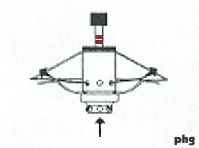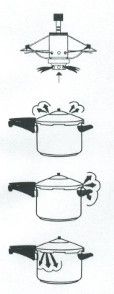Q: How do pressure cookers work?
A:The principle of pressure cooking is quite simple — and extremely effective. The temperature of water cannot rise above the temperature of boiling, and boiling temperature is dependent on surrounding air pressure. When heat is applied to a pressure cooker, the air pressure and the boiling point inside rise hand-in-hand. This allows cooking temperatures inside your food to rise to higher levels inside than they could otherwise.
For example, at sea level (where the pressure is 14.7 lbs per square inch), the boiling point of water is 212° F, the highest temperature that can be reached by water at that elevation. The boiling point is raised 38° (to 250° F) under the additional 15 pounds of pressure that can be obtained in a pressure cooker, and this higher temperature cooks your food much more quickly.
A secondary benefit of the increased pressure is that it softens the fibers in food, tenderizing even the toughest of meats and beans.
The increased internal temperature and the tenderizing effect on the fibrous nature of foods cooked under pressure combine to decrease normal cooking times by two-thirds or more.
Q: How is the Kuhn Rikon Duromatic Pressure Cooker's valve different from the old style weight valve?

When the first red ring appears, the internal pressure has been raised 8 pounds per square inch (psi) above the external pressure. When the second red ring appears, internal pressure has been raised 15 psi above the external pressure. The Quick Cuisine cookbook (included with every cooker) tells exactly how to use the ring indicator for each recipe, and provides guidelines and tables for using the same techniques for any food you may wish to prepare.

重量允许大量的蒸汽阀系统to escape. When a large amount of steam is escaping, there is a constant hissing noise, an increased likelihood of a clogged valve, and greater evaporation of moisture. Duromatic's valve allows cooking with less water (thereby retaining more of the vitamins, minerals and natural taste of the food), almost completely eliminates clogged valves, and is much quieter than cooking with a weight-valve system.
Q: At which temperature do I cook most foods?
A:Most foods can be cooked at the higher pressure (second red ring; 15 pounds per square inch.) Foods that have a tendency to foam, such as rice and soups, are cooked at the first red ring. Instruction manuals and recipes will indicate if cooking at the first red ring is desired.
Q: Should cooking times be adjusted at higher elevations?
A:Yes. Pressure cooking offers the same advantages at higher elevations as it does at lower elevations. But the increase in pressure within the cooker is relative, meaning that it is capable of doubling the normal pressure at a given elevation. Because this is true, for every 1000' of elevation over 2000', cooking times with a pressure cooker should be increased 5% over sea level pressure cooking times.
Q: What are the benefits of using a pressure cooker?
1)。健康的饮食习惯:Because very little water is used in pressure cooking and because the pressure cooker is a closed system, few vitamins or minerals are lost to the cooking water or dissipated into the air. Because they are not exposed to oxygen, vegetables not only retain their vitamins and minerals, but their vivid color as well.
Low fat, high protein beans and legumes, healthy additions to any diet, are frequently avoided because of their long cooking time under normal cooking conditions. In a pressure cooker, however, most beans and legumes can be cooked in less than 15 minutes.
2.) Better Taste:This is a direct result of the health benefits explained above. Also, for dishes such as stews and pasta sauces the pressure actually causes the ingredients to quickly mingle and their flavors to intensify. Pressure cookers keep the flavor in the food.
3.) Faster Cooking:The cooking times for most foods in the pressure cooker are approximately a quarter to a third the times for those same foods cooked in traditional manners and are, in many instances, faster even than a microwave. Some sample times:
4.) Economy/Efficiency:The decreased cooking times required with a pressure cooker results in a proportionate saving of energy consumption. Your energy bills are reduced, and our environment is spared the effects of unnecessary energy consumption.
5.) Comfort:Pressure cooking keeps three times as much heat contained in the cooker as convention cooking does, keeping your kitchen cooler. And because moisture also is retained in the pressure cooker, your working area stays less humid, too.
Q: What makes Kuhn Rikon Duromatic pressure cookers so safe?

A:The Duromatic pressure cookers by Kuhn Rikon represent a second generation of pressure cookers. These pressure cookers are built with safety features that prevent the problems sometimes seen with earlier cookers.
First, the automatic lid locking device of the Duromatic pressure cookers insures that no pressure can be built up until the lid is on properly. It also insures that the lid cannot be removed or come off until all of the pressure has been released.
The Duromatic cookers provide the ultimate in protection against excess pressure. The first indication that too much pressure has built up inside the cooker is the audible hiss of the valve as excess pressure is released through the valve (which is normally quiet.) When the user hears this, the heat should be turned down. As long as the valve is not clogged, it will relieve any over-pressurization by allowing steam to escape through the radial escape holes located on the valve stem.
Other safety releases will come into effect only if the central valve becomes clogged. If that occurs, excess pressure can also escape through the safety holes in the rim of the lid.
Additionally, another spring loaded safety valve is set to release steam in the case of a clogged main valve due to overfilling or too-high heat. This valve is not a blow plug like some old domestic cookers had, but a highly accurate spring loaded valve which will open at a preset internal pressure and release steam safely and effectively.
Finally, at higher pressure, the gasket is gently pushed out through the six bayonet flanges in the lid, and excess steam escapes in a downward direction.
Q: Why do Kuhn Rikon pressure cookers have a clad base?
A:One of the measures of cookware performance is its ability to transfer heat and distribute it evenly. This quality is called heat conductivity. The heat conductivity of a pan depends mainly on the material from which it is made and the thickness of that material. Kuhn Rikon combines the excellent qualities of stainless steel with the superior heat conductivity of aluminum to obtain cookware with the best qualities of both metals. This performance difference is particularly noticeable when browning meats in your Kuhn Rikon, prior to pressure cooking.
Q: Can I put my pressure cooker into the oven?
A:The Duromatic pressure cooker can go into the oven at settings below 300° F. Most foods prepared in a pressure cooker do not require placement in an oven for cooking. Sometimes you may want to put the smaller pressure fry pan into the oven to keep it warm, and that may safely be done at temperatures below 300° F.
Q: Do I need to clean the valve?
A:The multi-valve is self cleaning under normal use and therefore does not need to be unscrewed. If food particles have been expelled into the valve, it can be disassembled easily for cleaning, following the directions in the user's guide.
Q: Can I use the Kuhn Rikon on my induction cook top?
A:Yes! All Duromatic pressure cookers work on all cooking surfaces, including induction cook top.
Q: What are the dimensions of the various Kuhn Rikon models?
A:
To return to Kuhn Rikon Duromatic pressure cookers,.




